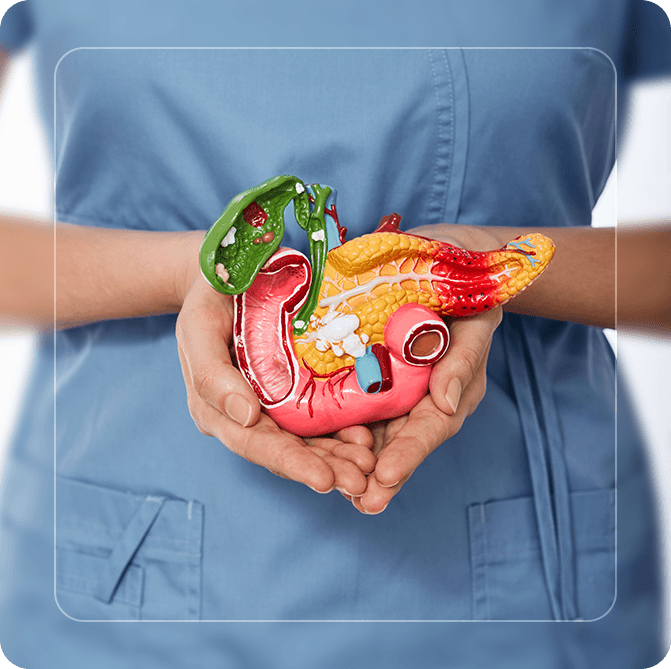Causes of Acute Pancreatitis
In the majority of cases, acute pancreatitis is caused by gallstones or alcohol consumption. Less common causes may be related to medication, a lipid disorder, viral infections, trauma to the abdomen, or auto-immune conditions. For a minority of patients, the cause of acute pancreatitis may be unknown.
In Singapore, the most common cause of acute pancreatitis is gallstones. The pancreatic duct and bile duct are joined together as they enter the small intestine, so gallstones can block the common channel, causing obstruction of the pancreatic duct and acute pancreatitis. For some patients, acute pancreatitis may be the first sign of gallstone disease.
Diagnosis of Acute Pancreatitis
Acute pancreatitis is suspected based on typical symptoms of severe upper abdominal pain, and risk factors such as heavy alcohol consumption or a history of gallstone disease. The diagnosis can be confirmed with blood measurement of two digestive enzymes – amylase and lipase. High levels of these two enzymes will strongly suggest acute pancreatitis.
Additional blood tests and clinical parameters are also taken to differentiate mild from severe acute pancreatitis. It is important to recognise attacks of severe acute pancreatitis as patients will need intensive monitoring and aggressive treatment.
Radiological imaging with ultrasound or CT of the abdomen will help confirm the diagnosis of acute pancreatitis and help establish the possible causes, especially gallstone disease.
Treatment of Acute Pancreatitis
Most attacks of acute pancreatitis are mild, and the treatment involves painkillers, hydration, and a period of fasting. In up to 20 percent of patients, pancreatitis can be severe and will require intensive care and medical procedures.
Most cases of mild acute pancreatitis usually last a few days, unless there is pancreatic necrosis (dead tissue in the pancreas) or fluid collections in or around the pancreas. Severe acute pancreatitis is more frequently associated with pancreatic necrosis and fluid collections.
Further attacks of acute pancreatitis can be largely prevented by removal of the gallbladder and gallstones, and alcohol avoidance. Gallstones that are obstructing the bile duct can be removed by endoscopy (the procedure is called ERCP, or “endoscopic retrograde cholangiopancreatography”).
Once the patient has recovered from the attack of acute pancreatitis, the gallbladder and all remaining gallstones should be removed by early laparoscopic cholecystectomy (a minimally invasive method to remove the gallbladder).
Should pancreatic necrosis or fluid collections around the pancreas develop, the clinical problem becomes more complicated and may require further interventions. Recent advances have allowed minimally invasive access to remove the dead tissue endoscopically (using a scope inserted via a natural orifice) or laparoscopically.
Percutaneous radiological drainage (drainage done through the skin with the help of X-ray images) is also a possible option for necrotic pancreas and fluid collection. These are the advances that have reduced the mortality rate compared to traditional open surgery and reduced the bleeding and infection rate related to severe acute pancreatitis.




